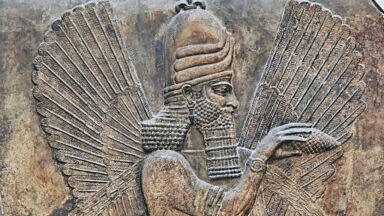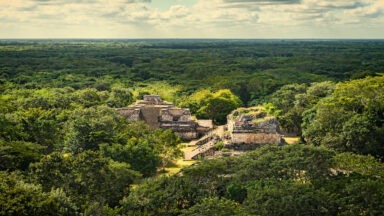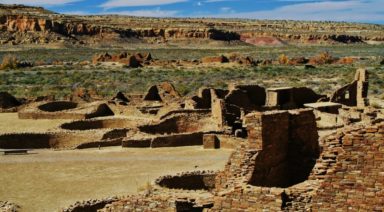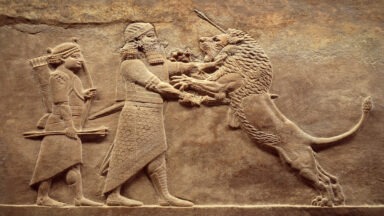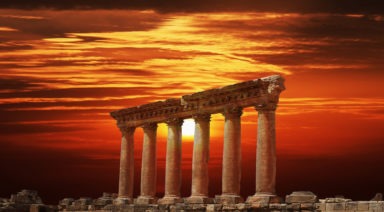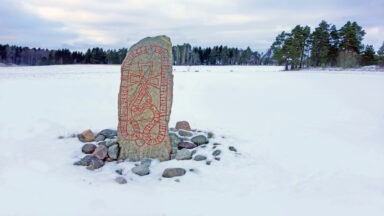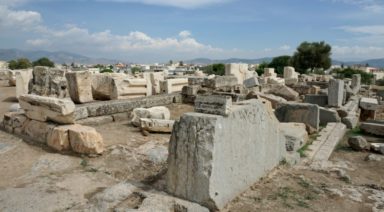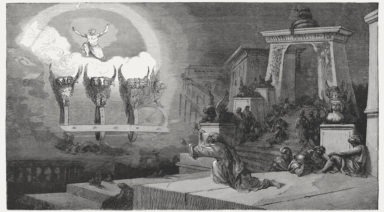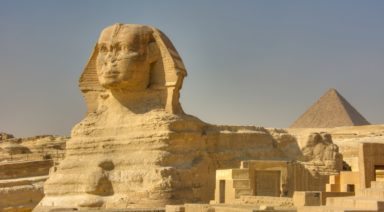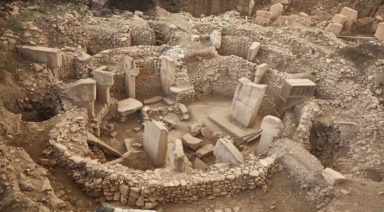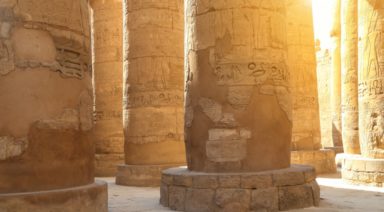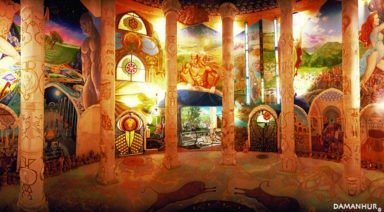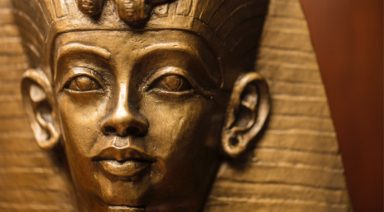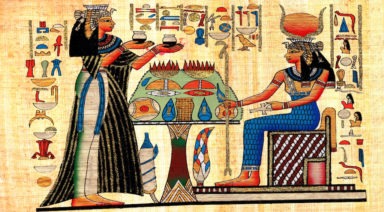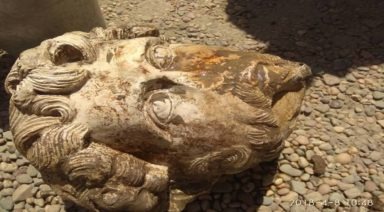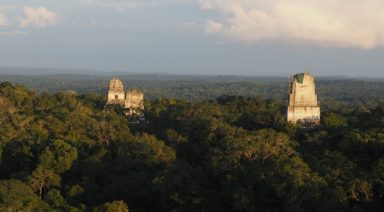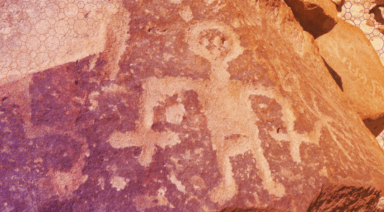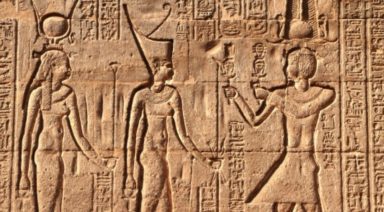Emerald Tablet 101: The Birth of Alchemy
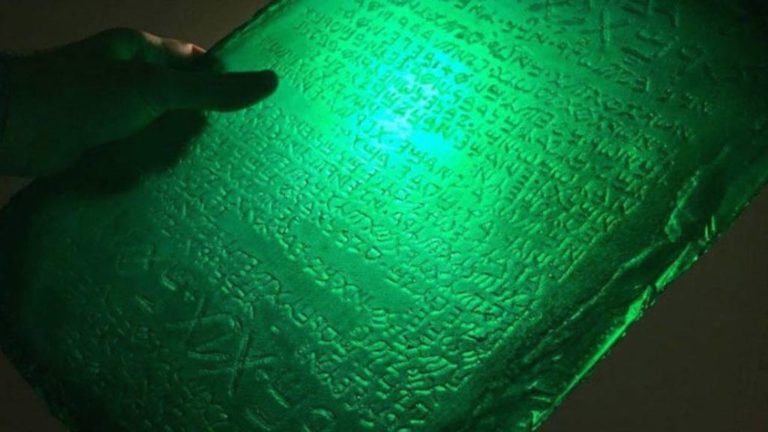
“As above; so below. As within; so without. As with the universe; so with the soul.” ~ Hermes Trismegistus
The story of the Emerald Tablet reads like the syllabus for an ancient civilization college course, with Egyptian pharaohs, Greek conquerors and philosophers, and travels through long-gone countries. While no one in the modern world has seen it, accounts of the Emerald Tablet of Hermes Trismegistus describe a slab of brilliant, crystalline green stone covered with bas-relief Phoenician text. Some believe the tablet holds the secrets of the universe.
Considered the original source of hermeticism, gnosticism, Western alchemy and science, the tablet is inseparable from the elusive Hermes Trismegistus, an ancient philosopher, healer and sage. References to Trismegistus can be found in Renaissance, Christian, Islamic, Roman and Greek literature.
No one knows what became of the original tablet — what remains are translations and translations of translations, along with a historic timeline punctuated with disconnects and gaps. The tablet appears and disappears across the ancient world, before and after the birth of Christ, with periods of revival, including the Italian Renaissance.
Dennis William Hauck, author of the classic “The Emerald Tablet,” wrote, “One of the most mysterious documents ever put before the eyes of man, the Emerald Tablet has been described as everything from a succinct summary of Neoplatonic philosophy to an extraterrestrial artifact or a gift from Atlantis.” The tablet’s premise that “All is One,” and that direct experience of the Divine is possible through meditation and psychological exercise, became the foundations of Freemasonry, and later Theosophy and esoteric schools including The Golden Dawn.
Balinas, Hermes Trismegistus and Apollonius of Tyana
Believed to have been a contemporary of the historical Abraham of the Old Testament, Hermes Trismegistus, a.k.a. Apollonius of Tyana, was said to have travelled throughout Egypt, Greece and Mesopotamia. He was associated with Thoth, the Egyptian god of wisdom, writing, magic and the sciences — patron god of the sacred scribes. Thoth’s name and qualities were synonymous with the Greek god Hermes — and the earthly Hermes’ honorific “Trismegistus” translates to “thrice great.” Some assert that the man was, in fact, the god incarnate.
Born in 16 C.E. in Anatolia, now Turkey, Balinas, later known as Apollonius of Tyana, was the son of Greek parents. Third century Greek biographer Philostratus wrote that before Balinas was born, his mother dreamed of a Greek sea god. She asked what kind of person her child would be, and the god said, “he will be me,” and revealed his identity as Proteus, the god of Egypt.
According to Hauck, as a child growing up in Tyana, Balinas pestered his parents and teachers with unanswerable questions, such as, “What is the true nature of existence?” When he was 14, and had exhausted the knowledge of local tutors, his parents sent him to a teacher in Tarsus, near the Turkish Mediterranean coast. The tutor, the Phoenician Euthydemus, exposed Balinas to Pythagorean knowledge and introduced him to students of Plato.
Legend has it that Balinas discovered the cavern holding the Emerald Tablet and hermetic texts, and spent the remainder of his life mastering their contents. Hauck writes, “Balinas taught that just as the “One Thing” [Divine source] exists in the universe, so it is mirrored in each of us and exists as “soul,” which evolves through reincarnations as it seeks perfect expression — man is only a temporary carrier of something with a greater purpose.”
Balinas spent the rest of his life travelling the ancient world from Greece and Egypt to Persia, North Africa, Spain and Europe, and eventually India. Many believe that Pythagoras travelled to India as well — if so, this would be an important moment of contact between Eastern and Western spiritual and esoteric traditions. Eventually, after advising Roman rulers Vespasian, Titus, and Nerva, he became known as Apollonius of Tyana.
Because of his uncompromising honesty, Apollonius offended the Emperor Nero, who arrested him for high treason. Hauck writes that at the trial, charges disappeared from the parchment and “the Tribunal was forced release him.” Later, Roman emperor Domitian (81 to 96 C.E.), known for his authoritarian, hyper-moralistic reign, arrested and tried Apollonius. It is reported that he entered the courtroom and “descended into a meditative state that swept over everyone present — Domitian became confused, and in an entranced voice, acquitted Balinas,” Hauck writes. Prior to the trial, while in confinement, Apollonius is said to have slipped out of his chains and taught other prisoners meditation methods from the Emerald Tablet.
Egyptian Thoth: The Original Hermes
Who created the tablet and the 42 books of the Hermetica that includes alchemy, astrology, philosophy, geography, medicine, theology, and music texts? A deeper look into legend reveals that Thoth, an ancient figure straddling the realms of humans and gods, was the author of the Emerald Tablet and accompanying texts. Because of cultural cross-pollination between Greece and Egypt, Thoth was adopted by the Greeks as the god Hermes.
In Jewish, Christian and Islamic traditions, Thoth is thought to be Seth, the younger brother to Adam and Eve’s older sons Cain and Abel. Gnostic traditions hold that Seth/Thoth is the earliest ancestor of Noah, Moses, Abraham, Enoch, and Jesus. Seth/Thoth also inspired one of the earliest Gnostic cults, the Sethians, who heavily influenced modern Christian tradition and beliefs. Some scholars assert that the Torah is the “Lost Book of Thoth.”
Hauck tells us that “Thoth is impossible to categorize because he transcends definitions of gods and men.” At the Egyptian Temple of Seti, dated 1300 B.C.E., is an image of Thoth with the head of an ibis and an early caduceus, now a symbol of medicine. “The Book of Breathings,” said to be one of his scrolls, is instruction on how to develop the consciousness to survive beyond death — the immortality sought by alchemists through history.
Alexander the Great
The first Hermes, synonymous with Thoth, was said to be the son of Agathodaimon, the Great Thoth; god of all learning, knowledge and sacred scribes. When Alexander the Great conquered Egypt, around 331 B.C.E., he became pharaoh, with access to all the ancient treasures of that country. He was obsessed with finding the tomb of Thoth, as he was told it contained secrets that could turn a man into a god.
Alexander located the tomb, tablet and cache of texts in present-day Libya. Retaining scholars and priests to copy and translate texts, Alexander commenced construction of the Library of Alexandria, dedicated to the study of the tablet and texts, called the Hermetica.
As the story goes, Alexander, with his armies, left for the east to conquer India, taking the Hermetica with him. On the way, he hid the tablet and texts in a cave, never to return — he died while on campaign.
It was that cave where young Balinas discovered them 300 years later. And it was Balinas who absorbed the tablet’s teachings and brought them to the light of human consciousness.
But accounts differ; ancient reports say that before the biblical Great Flood, Thoth build two great pillars, one emerald green and one gold, and placed all his scrolls, teachings, and sacred objects within. Hauck reports, “Egyptian records state that Thoth had authored 36,525 manuscripts, though that was just another way of stating that he wrote down the sum of all knowledge.”
According to the historian Herodotus, the pillars were discovered thousands of years later near the Egyptian cities of Heliopolis and Thebes. After, the pillars were placed in the Temple of Thebes, the oldest temple site in Egypt, and it was there that they were discovered by Alexander the Great.
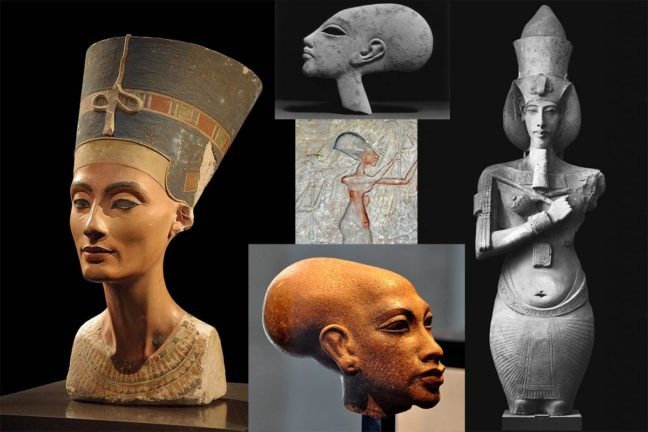
Left: Nefertiti, wife of Akhenaten. Center top and middle: Akhenaten head and bas-relief. Bottom: Akhenaten’s daughter Meritaten. Right: Akenaten sculpture.
The Second Hermes: Akhenaten
Akhenaten was perhaps the strangest pharaoh in the 32 Egyptian dynasties. His wife was the spectacularly beautiful Nefertiti, and in his time, the 18th Dynasty (roughly 1330 B.C.E.), he was described as androgynous, often shown as a gender-neutral figure with a dramatically elongated skull, inherited by at least one of his daughters.
Now called by some the “extraterrestrial pharaoh,” Akhenaten disrupted almost every aspect of Egyptian religion and culture. Some speculate that after finding the Emerald Tablet early in his reign, he changed his birth name from Amenhotep IV, to Akhenaten, meaning “he who serves the Aten (the one thing)” as a result of revelations he received from the text.
Akhenaten challenged the powerful Egyptian priesthood, and their pantheon of gods and goddesses, when he declared himself the father of a new, monotheistic religion. He asserted that there was only one source of creation, represented by the solar sun. He called this singularity “Aten,” represented by a solar disk emanating rays from heaven to earth. The underlying principle of the one thing was light — luminous, cosmic light as the source of all — the Holy Light.
The rogue pharaoh broke other taboos by raising the status of women in Egyptian society and discarding prohibitions against men and women sharing quarters. Under his rule, artistic portrayals became more expressive and lifelike, as opposed to traditional stiff profiles.
Emerald Tablet scholars speculate that Akhenaten’s inspiration came from the tablet itself. Historical documents record his efforts to apply principals from the tablet to his governance; he promoted concepts, then revolutionary, such as living in truth and living in accord with natural, cosmic law. Called the “heretic pharaoh” by the powerful religious institutions, Akhenaten named his singular deity “Maat,” meaning “the real thing.” Some historians believe Akhenaten’s writings were the source of later Jewish and Christian monotheistic “one god” religions.
Some believe the pharaoh added the “Operation of the Sun,” to the tablet, a ritual he reportedly performed that became a classic alchemical recipe. Akhenaten was, in the tradition of Hermes/Thoth, a superb writer, leaving his poem “Great Hymn to Aten” as part of his legacy.
Portrayed as an eccentric fool by historians, Akhenaten ruled for 17 years. While no one knows precisely what became of he and Nefertiti, it is accepted that they were assassinated by the now-disenfranchised, patriarchal priesthood. He was replaced by the 10-year old Tutankhamun, but is still believed by many to be an incarnation of Thoth/Hermes.
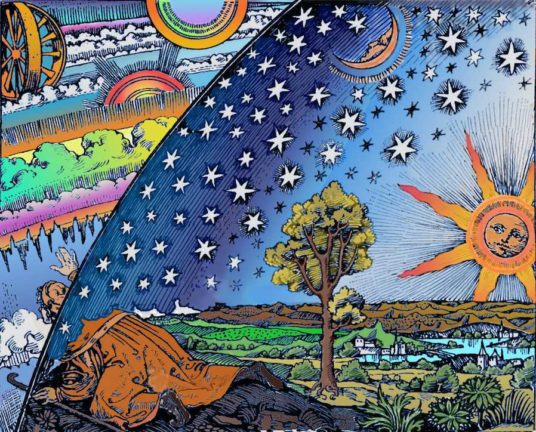
The Spiritual Pilgrim — 16th century German woodcut. A seeker pierces the illusory veil of the material world and glimpses the reality beyond.
The Emerald Tablet and European Alchemy
After the Crusades, alchemy from the middle east migrated to Spain and the rest of Europe. Englishman Robert of Chester translated an early alchemical text, obtained in Spain, from Arabic to Latin in 1144. Later, 13th century Dominican monk, Albertus Magnus, wrote a commentary on the Emerald Tablet, demonstrating that the Hermetica had arrived in Europe. Other works found their way to Europe through the Arabic alchemists of Spain and became additional sources for Western alchemy, astrology, numerology, and chemistry, metallurgy, and esoteric philosophy.
The Renaissance brought alchemy to even greater popularity in Italy, France, England, Germany and Eastern Europe, with Prague, in Bohemia (the Czech Republic) as the center of European alchemical study. Rudolf II of Bohemia established the Prague alchemical schools and issued invitations for practitioners to come and demonstrate their skills. Today tourists visit the Museum of Alchemists and Magicians located in Prague’s old town city center.
Alchemical arts fell into disrepute as pretenders and con artists exploited those greedy for gold. For a time, in England and Rome, alchemy was punishable by death and practitioners fled. Hermeticism was driven underground, and many legitimate texts were destroyed or lost to time. But in the 15th and 16th centuries alchemy appeared again as a “spiritual” endeavor when Sir George Ripley wrote “Compound of Alchemy” dedicated to the Plantagenet king Edward IV.
European and English alchemy persisted through the 17th and 18th centuries — physicians derived formulas for treatments from alchemical processes, establishing the practice of Hermetic Medicine. Rumors and stories of alchemists’ miraculous deeds and transmutations kept “The Great Art” alive, inspiring others to spend their lives searching for the ultimate achievement — the Philosopher’s Stone.
The Philosopher’s Stone
Alchemical traditions, whether European, Middle Eastern, or Asian, pursue the same prize — the creation of the Philosopher’s Stone, a.k.a. the Pearl of Great Price, the Wish-Fulfilling Jewel, the Heart of the Sun — the tool that turns base lead to gold.
Hermes Trismegistus’ “one thing” became the “materia prima,” or first matter, the source of all existence; Aristotle described it as the invisible force that contains all the universe. From the materia prima come the elements; fire, water, air and earth, the fundamental constituents of all life. The elements are utilized in the classic seven steps for producing the stone. They are:
- Calcinate: Reducing a substance to ashes. Purification by fire.
- Dissolution: Dissolving ash into a liquid. Purification by water.
- Separation: Filtering and separating the products of dissolution. Purification by air.
- Conjunction: Recombining into a new substance. Purification by earth.
- Fermentation: Breaking down the substance by decomposition.
- Distillation: Boiling and condensing. Produces a more refined substance, as in making wine or spirits.
- Coagulation: The final step — the substance is transmuted into a crystalline, or solid state, resulting in the Philosopher’s Stone.
This process, referred to as the Magnum Opus, or “Great Work” by alchemists, requires ear whispered instruction by a master; texts alone leads seekers down blind alleys and dead ends after years of work.
The true solution, or ultimate insight to be discovered by the wise, is that the alchemical process is an allegory of spiritual development — inescapable psychological steps through which each individual must pass to reach realization. It is the ultimate transmutation, turning the “base,” leaden ego to gold, or enlightenment, via steps of destruction and refinement. To the master, producing physical gold is the inferior result — transmuting and refining the soul is the true prize.
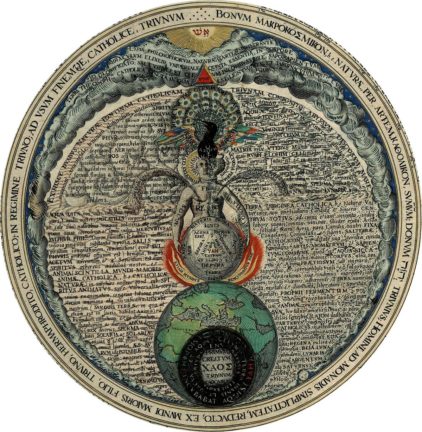
The Search for the Philosopher’s Stone: From Heinrich Khunrath’s alchemy text “Amphiteatrum Sapientiae Aeternae,” 1595
The Alchemical Legacy
Joseph Campbell’s “Hero’s Journey” describes the alchemical process found in myth; allegories of the soul’s trials, tribulation, refinement, and rebirth. And an Eastern alchemical metaphor can be tied to Cinderella as the lotus blooming from the pond’s muddy bottom.
Groundbreaking psychologist Carl Jung famously said, “For the alchemist, the one primarily in need of redemption is not man, but the deity who is lost and sleeping in matter [human flesh].” Like a snake with its tail in its mouth, Jung’s words close the circle begun by Hermes Trismegistus — that the true philosopher’s stone, that which fulfills all wishes and grants god-like powers, is the human imagination, obscured by the lead of ego and false identity, fear, confusion, and the common belief that the individual is powerless.
The alchemical process has appeared in literature as early as fairy tales such as The Golden Goose and The Frog Prince. Alchemical references can be found in Shakespeare’s Macbeth (blood as tincture), King Lear (Cordelia as a healing balm), and Hamlet. English 18th century poet William Blake was spiritually mentored by the writings of Renaissance alchemist Paracelsus. More recently, J.K. Rowling’s “Harry Potter and the Philosopher’s Stone” harkens back to the “Great Work.” The 2014 horror film “As Above, So Below” leans heavily on Dante’s Inferno, the alchemist’s process of purification of the soul, and the discovery of the true philosopher’s stone.
Hauck writes, “The power of consciousness is the imagination, though the ancients would have called it the “word,” or “thought” of God. According to the Emerald Tablet, that power is reflected below in the mind of man.” Everything, from the monsters of nightmares to the understanding of complex physics, is the product of imagination.
Quoting the “Lexicon of Alchemy,” Hauck writes; “Imagination is the Star in Man, the celestial or supercelestial body. Therefore the imagination is a divine gift; the piece of heaven concealed in man.” Only by persistence and deep resolve may one experience the true potential of the imagination — the human co-creative capacity that we endeavor to understand even today.
The Emerald Tablet
‘Tis true without lying, certain & most true.
That which is below is like that which is above & that which is above is like that which is below to do the miracles of one only thing.
And as all things have been & arose from one by the mediation of one: so all things have their birth from this one thing by adaptation.
The Sun is its father, the moon its mother, the wind hath carried it in its belly, the earth is its nurse.
The father of all perfection in the whole world is here.
Its force or power is entire if it be converted into earth.
Separate thou the earth from the fire, the subtle from the gross sweetly with great industry.
It ascends from the earth to the heaven & again it descends to the earth & receives the force of things superior & inferior.
By this means you shall have the glory of the whole world
& thereby all obscurity shall fly from you.
Its force is above all force. For it vanquishes every subtle thing & penetrates every solid thing.
So was the world created.
From this are & do come admirable adaptations whereof the means (or process) is here in this. Hence I am called Hermes Trismegist, us having the three parts of the philosophy of the whole world.
That which I have said of the operation of the Sun is accomplished & ended.
Did The Vikings Use a Solar Stone Crystal to Navigate Cloudy Seas?

Vikings dominated the North Atlantic seas for at least 300 years, but how did they sail across great distances with incredible accuracy, without a magnetic compass? A long-held theory about Vikings using crystals for navigation may have been proven true with modern science.
The Vikings, the great north seamen, sailed from Norway to Greenland and many parts in between. They were known to have amazing maritime navigation skills, by using the sun to plot their position on the globe. But scientists have wondered for years how they could navigate when they couldn’t see the Sun. Enter the sunstone, or solar sign, a crystal that when held up to a cloudy sky, can help to locate the Sun.
For years the use of Sunstones has been nothing but a theory based on a legend. Such as this mention in the tale Rauðúlfs þáttr:
“The king made people look out and they could nowhere see a clear sky. Then he asked Sigurður to tell where the sun was at that time. He gave a clear assertion. Then the king made them fetch the solar stone and held it up and saw where the light radiated from the stone and thus directly verified Sigurður’s prediction.”






